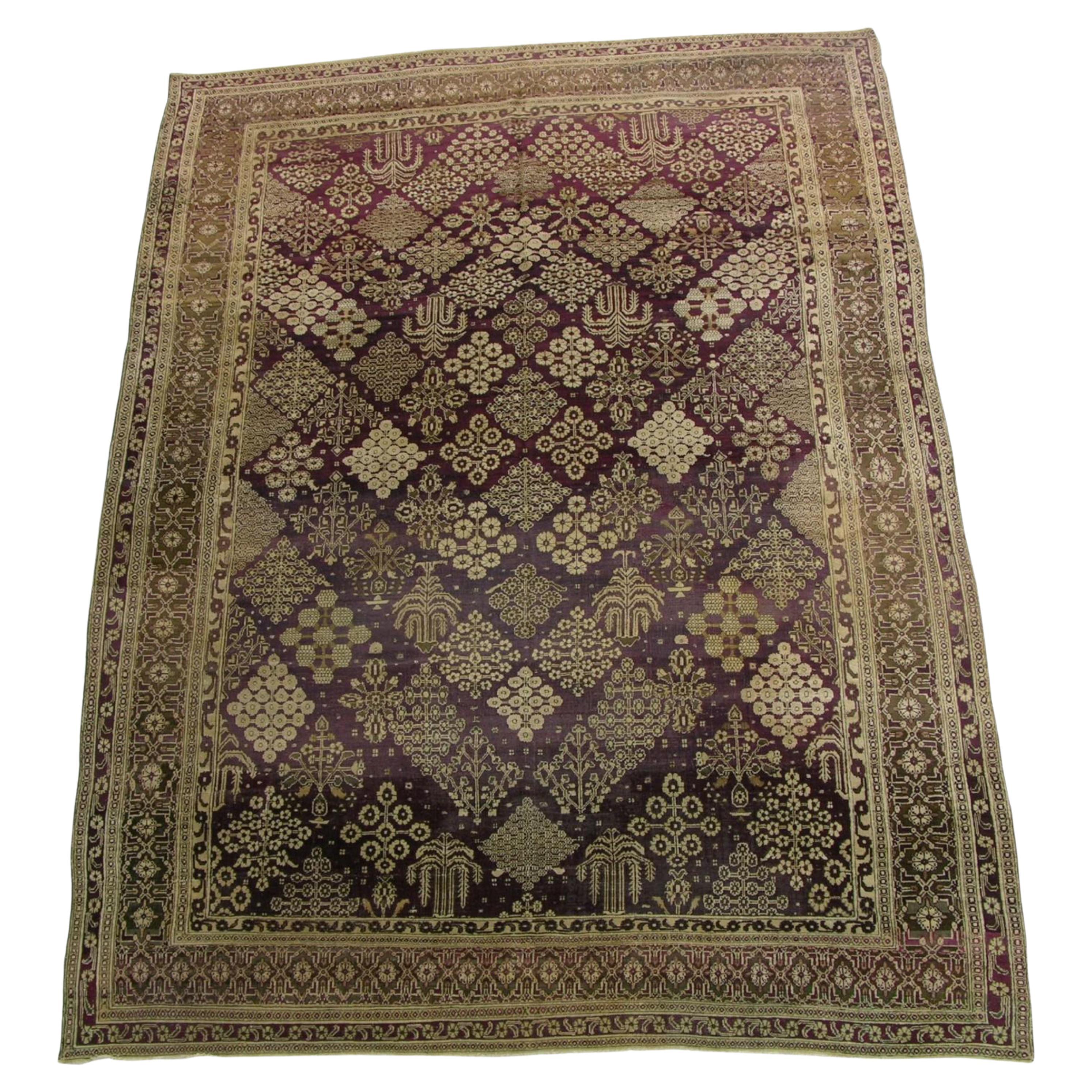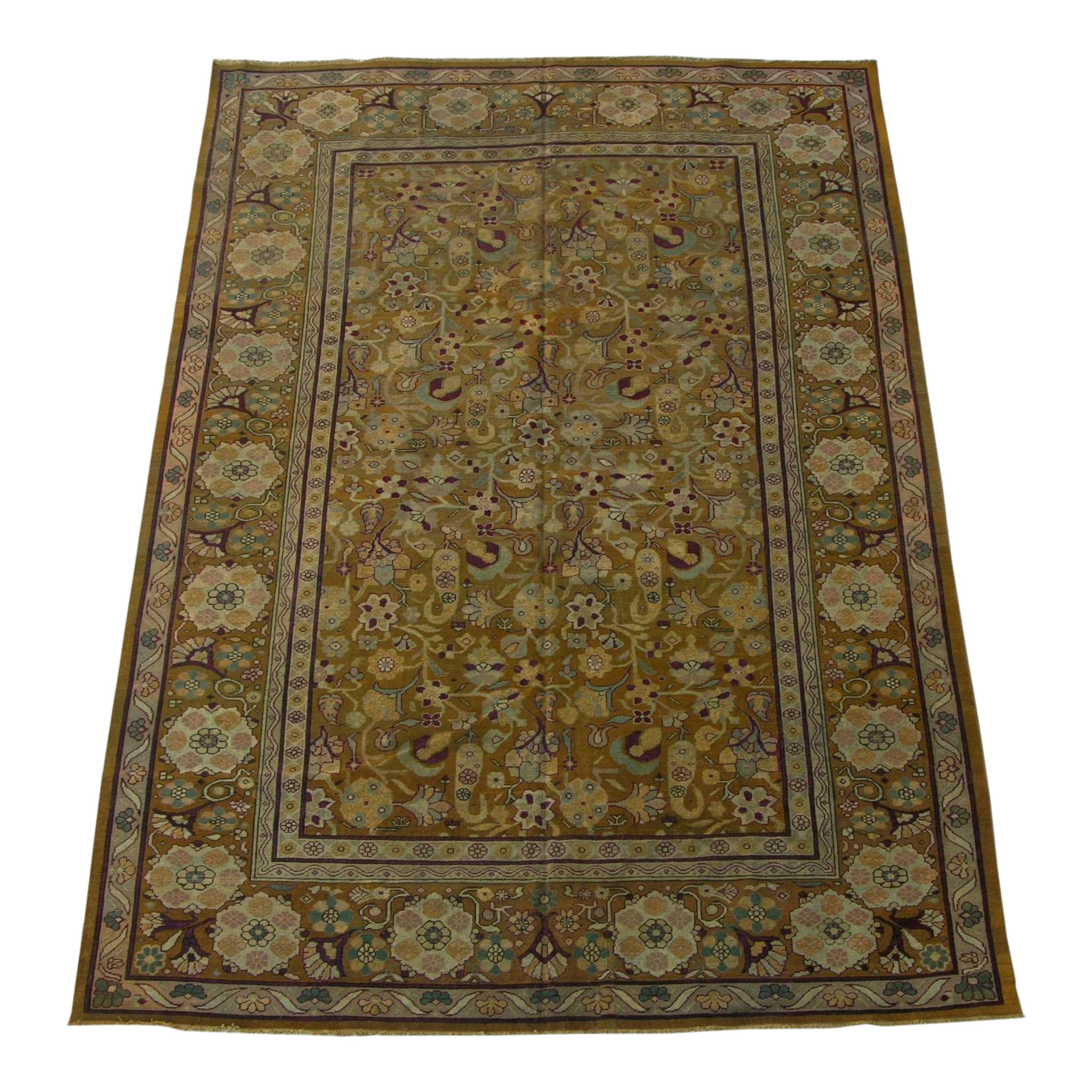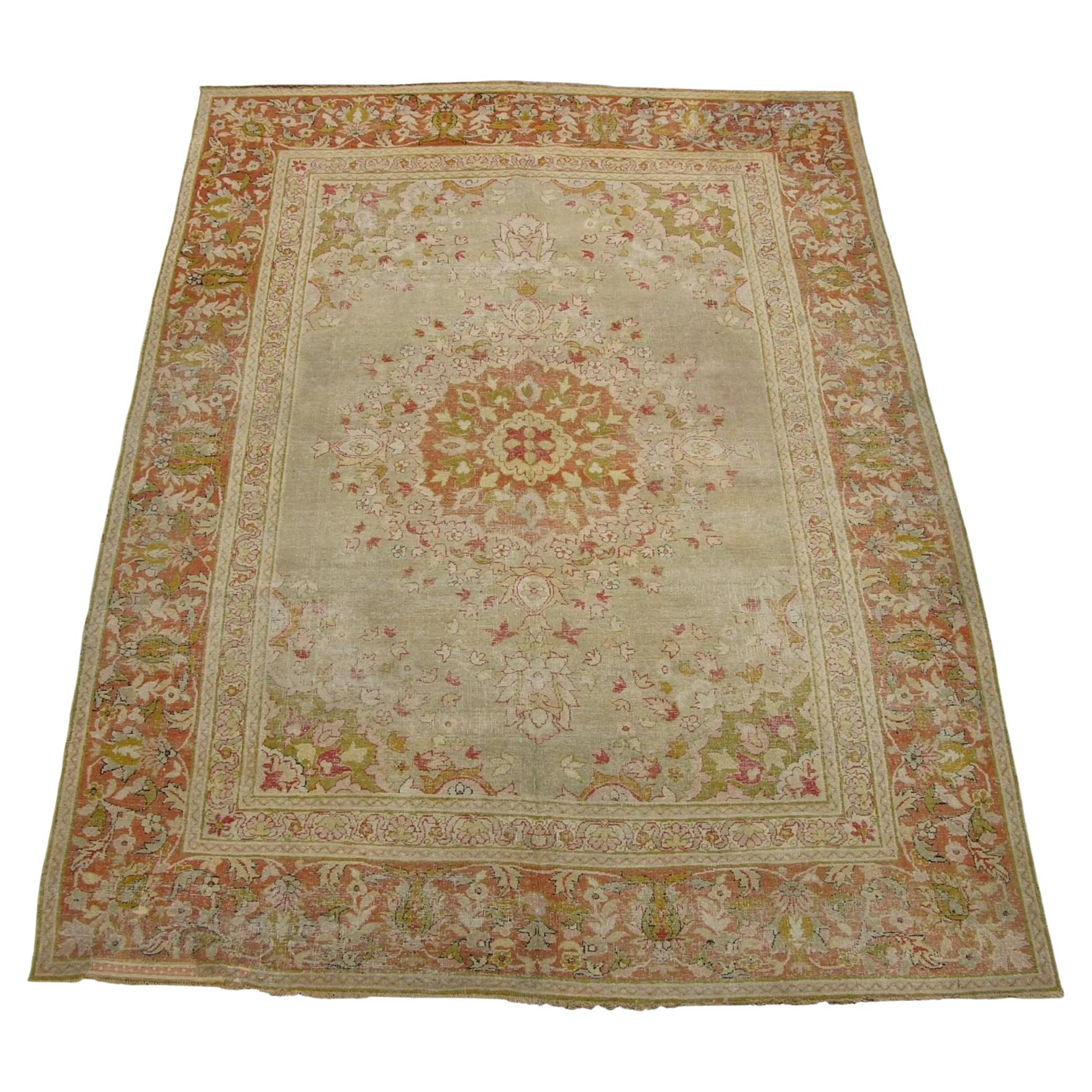Items Similar to 1900s Antique Indian Rug - 16'2'' X 12'0''
Want more images or videos?
Request additional images or videos from the seller
1 of 5
1900s Antique Indian Rug - 16'2'' X 12'0''
About the Item
Antique Agra Rugs Agra has been a major center of area rug and carpet production since the great period of Mughal art in the sixteenth and seventeenth centuries. When the carpet industry was revived there under British rule in the nineteenth century, the great Mughal tradition got a new lease on life, accompanied by a new interest in the sorts of classically derived designs current in Persian rug production during the same period. Because of this, nineteenth and early twentieth century Agra carpets enjoyed a varied and eclectic background that could draw on all the great achievements of Oriental carpet weaving. Antique Agra rugs present elegant allover designs alongside medallion or centralized patterns. They have the rich pungent palette of classical Indian and Persian carpets as well as soft, cool earthy tones.
Located in the Uttar Pradesh state in northern India, the city of Agra is most widely recognized for the Taj Mahal, the Mughal Emperor Shah Jahan’s mausoleum for his third wife.
Less widely known is that Agra has also been a large center for rug weaving since the 16th century. When Agra first became the Mughal capital in 1566, it also established its presence as a rug weaving center. The Indians themselves had never had much need for large carpets and the craft was introduced relatively late. During the 17th century, a number of skillful Persians were called in to impart their weaving knowledge in India. Large carpet factories were started in Lahore; the patterns as well as the knotting closely resembled Persian work. A number of antique carpets from this time are now found in museums throughout Europe and America. Production of fine rugs continued here through the decline of the Mughal Empire in the 17th century after which most antique Agra rugs were categorized as Indo Isfahan weaving.
Since the end of the 19th century rugs in India have been primarily woven to order and have been made with the finest quality in mind. Although later rugs do derive patterns from their predecessors, the changing style of Agra carpets can be most clearly seen during the British rule of the 19th and 20th centuries. Production ceased after the 1920’s but resumed again in more recent times. Now, Agra carpets are considered some of the most decorative pieces internationally.
Agra Rugs are difficult to classify as they vary in size, design, and composition. Although they often exhibit open fields with smaller medallions and guards, they can also be woven with all-over designs. Similarly, the fields are usually composed of olive greens, blues, fawns, and tans, but can also be red or other colors. They are usually woven with wool, but can also be found with cotton. The older Mughal pieces are relatively rare (they are usually found in fragments or are re-sized and heavily restored) and as such are much more valuable. The weight of an Agra is one telling factor between the older Mughal Agra carpets which are lighter and the newer Agra rugs that are heavier.
It is also difficult to tell Agra rugs apart from other types of Indian rugs such as Amritsar rugs. Many times dealers will label a piece as an Agra as the connotation is much better than Amritsar, but this is a misnomer. While the definite location of any one piece is hard to distinguish, one can be sure that real antique Agra carpets are fine pieces and great for collectors and designers alike.
History of Antique Indian Agra Carpets:
Agra lies on the Yamuna River in the state of Uttar Pradesh, India. The ancient origins of the city, dated to least 1000 BCE, are referenced in the Mahabharata, although not well-documented. Sikander Lodi, Sultanate of Delhi, made Agra his capital in the early 1500’s CE. It is today most well-known as the location of the Taj Mahal, built under Mughal ruler Shah Jahan. Agra Fort and the fortified city of Fatehpur Sikri, both built by Mughal ruler Akbar, as well as the Taj Mahal, are UNESCO World Heritage Sites in Agra.
The inception of carpet weaving on a grand scale in India can be pinpointed to the arrival of the Mughals in India in the 1500’s. When Mughal Emperor Babur (1483-1530) conquered India and took Delhi in 1526, he lamented the lack of fine objects and comfortable environment that he had experienced prior to occupying his new capital in Agra. He brought with him some of the trappings from his native land and territories under his domain, including carpets. He did not establish weaving centers or try to create these textiles in his new homeland; instead, he imported them from Iran.
- Dimensions:Width: 144 in (365.76 cm)Length: 194 in (492.76 cm)
- Style:Empire (In the Style Of)
- Materials and Techniques:
- Place of Origin:
- Period:1900-1909
- Date of Manufacture:1900
- Condition:Excellent Condition.
- Seller Location:Los Angeles, US
- Reference Number:
About the Seller
5.0
Gold Seller
These expertly vetted sellers are highly rated and consistently exceed customer expectations.
Established in 1920
1stDibs seller since 2023
26 sales on 1stDibs
Typical response time: <1 hour
- ShippingRetrieving quote...Ships From: Los Angeles, US
- Return PolicyA return for this item may be initiated within 3 days of delivery.
More From This SellerView All
- 1900s Antique Indian Rug - 14'8'' X 12'0''Located in Los Angeles, USAntique Indian Rugs – Not all the rugs that were woven in India are easy to categorize. That is why we created this antique Indian rugs section. Here you will find Indian rugs of whi...Category
Antique Early 1900s Indian Empire Indian Rugs
MaterialsWool, Cotton
- 1900s Antique Indian Agra Rug - 12'0'' X 8'9''Located in Los Angeles, USAntique Agra Rugs Agra has been a major center of area rug and carpet production since the great period of Mughal art in the sixteenth and seventeenth centuries. When the carpet indu...Category
Antique Early 1900s Indian Empire Indian Rugs
MaterialsWool, Cotton
- 1900s Antique Indian Agra Rug - 12'5'' X 11'10''Located in Los Angeles, USAntique Agra Rugs Agra has been a major center of area rug and carpet production since the great period of Mughal art in the sixteenth and seventeenth centuries. When the carpet indu...Category
Antique Early 1900s Indian Empire Indian Rugs
MaterialsWool, Cotton
- 1900s Antique Indian Amritsar RugLocated in Los Angeles, USDuring the period of Colonial rule over India, Amritsar rugs began to reflect Western influences in their design. The craftspeople of Northern India took their chance to profit from ...Category
Antique Early 1900s Indian Tribal Indian Rugs
MaterialsWool, Cotton
- 1900s Antique Indian Amritsar RugLocated in Los Angeles, USDuring the period of Colonial rule over India, Amritsar rugs began to reflect Western influences in their design. The craftspeople of Northern India took their chance to profit from ...Category
Antique Early 1900s Indian Other Indian Rugs
MaterialsWool, Cotton
- 1900s Antique Indian Amritsar Rug - 10'6'' X 7'9''Located in Los Angeles, USDuring the period of Colonial rule over India, Amritsar rugs began to reflect Western influences in their design. The craftspeople of Northern India took their chance to profit from ...Category
Antique Early 1900s Indian Empire Indian Rugs
MaterialsWool, Cotton
You May Also Like
- Antique Cotton Agra Rug, circa 1880 14'4" x 16'2".Located in Secaucus, NJThis is a very attractive light and open piece. The ivory field is full of soft colors, all complimented by the border, to create a rug that has a relaxed and restful feel, that will...Category
Antique 1880s Indian Rugs
MaterialsWool
- Antique Indian Agra Rug, circa 1900 9' x 12'2Located in New York, NYAntique Indian Agra rug, circa 1900. The pattern is endless in this decorative antique Agra carpet. Appearing to pass beneath the border the array of angular vine segments sectional ...Category
Antique 19th Century Indian Agra Indian Rugs
MaterialsWool
- Handmade Antique Indian Amritsar Oriental Rug, 1900s, 1B147Located in Bordeaux, FRAntique Indian Amritsar rug in burgundy and beige shades. The true masterpiece of its kind with all over design and detailed floral style.Category
Early 20th Century Indian Indian Rugs
MaterialsWool
- Antique Indian Agra Carpet, circa 1900sLocated in New York, NYThe shaped pale camel open field is dramatically set off by a tall oval medallion with black details and a central arabesque ivory quatrefoil. The abrashed tan border show selected p...Category
Antique Early 1900s Indian Agra Indian Rugs
MaterialsWool
- Antique Indian Rug 16'. 0" x. 16' 0"Located in New York, NYAntique Indian rug, size: 16'0" x 16'0".Category
Vintage 1920s Indian Indian Rugs
MaterialsWool
- 1900s Indian Amritsar Botanic Handmade Wool RugLocated in New York, NY1900s Indian Amritsar botanic handmade wool rug Size: 11'9" x 15'8" (358 x 477 cm) While India does in fact boast a long history of weaving, Amritsar rugs are unique in the wide gamu...Category
Early 20th Century Indian Indian Rugs
MaterialsWool





